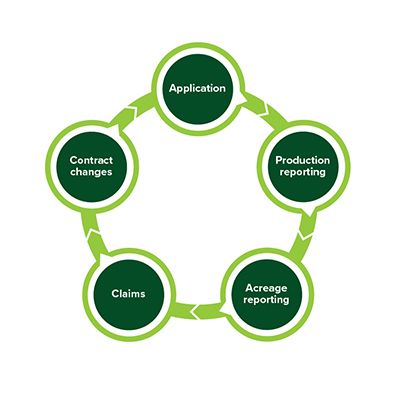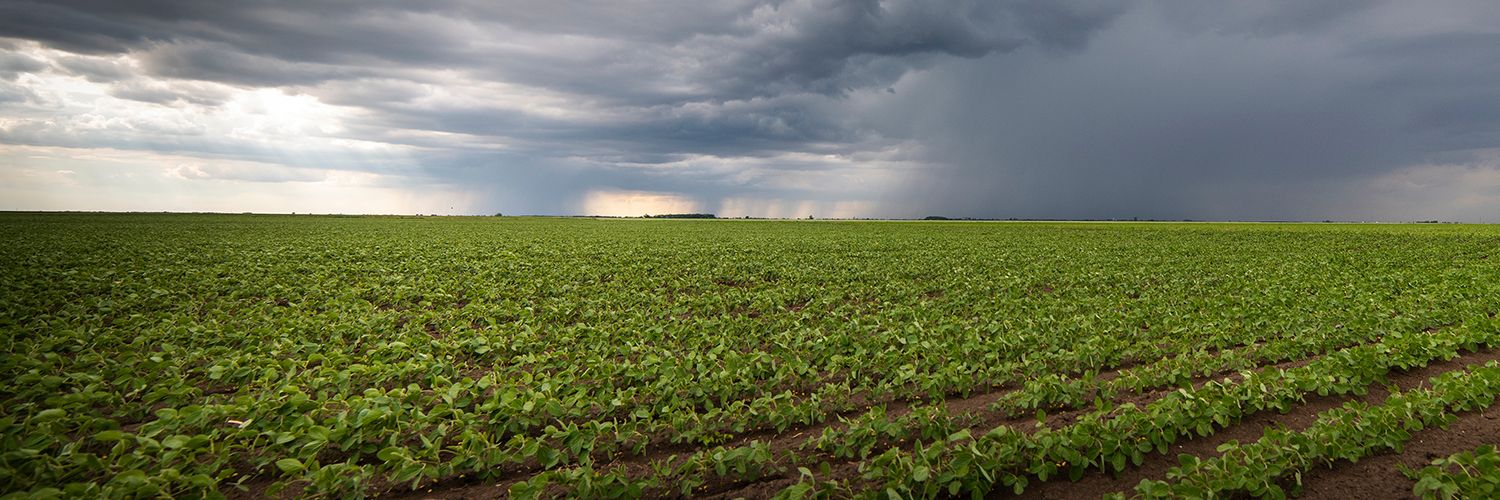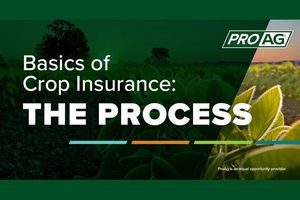The Risk Management Association (RMA) and the Crop Insurance industry activities follow a timetable known as the Crop Insurance cycle. The cycle begins when the Federal government releases information about insurance products for the upcoming crop year and ends with the release of changes to the program for the following year.

The initial application for insurance is filled out in an agent’s office and then electronically submitted to an approved insurance provider (AIP). All applications must be on file with the agent by the applicable sales closing date (SCD). These dates vary by crop, region, etc.
The most common sales closing dates (SCDs) are:
- 3/15 and 9/30 – Annual Crops (crops which are planted every year)
- 1/31 and 11/20 – Category C / Perennial Crops (crops which are not planted every year)
During the application process, the ag producer must decide which crops to insure and at what level of coverage. Policies are based on specific crop and counties.
If the insured chooses to insure a crop in a county, he/she must insure all acres of that crop in that county. For example, if the insured chooses to insure wheat in Saint Charles county, he/she must insure all acres of wheat planted in Saint Charles county. He/she cannot choose to insure non-irrigated wheat and not insure the irrigated wheat acres. However, he/she can choose to not insure corn planted in Saint Charles county or wheat planted in another county.
The insurance coverage is continuous and automatically renews unless canceled in writing by either ProAg or the policyholder by the cancellation date, which is typically the same as the sales closing date (SCD).
As a result, this is also the time insureds have the opportunity to review any changes and, if desired, change the policy coverage, or cancel the insurance coverage. Any changes the insured makes must be submitted no later than the crop sales closing date. If the changes are not filed prior to the sales closing date (SCD), the changes take effect the following crop year. If the insured wishes to cancel the policy, a written notice must be submitted on or before the crop cancellation date.
Individuals and Entities
The applicant may be an individual or an entity. An entity has its own distinct existence. For example, an organization has a legal identity which is separate from those of its members.
Entities are vital to the insurance policy because insurance only extends to the individual or entity listed as the named insured on the application. It is extremely important for the agents to verify the name listed on the application is the name in which the crop is sold to ensure coverage is not voided and to eliminate potential issues when / if there is a claim.
For example, an individual, Bob Farmer, purchases a Crop Insurance policy, but actually does business as Farmer Farms, LLC. If part of the crop is damaged, there is no loss payment because Farmer Farms, LLC does not have coverage on the crop(s). Likewise, if Farmer Farms, LLC purchases the policy, Bob Farmer, as an individual, does not have coverage.
Substantial Beneficial Interest (SBI)
To apply for a Crop Insurance policy, the applicant, also known as the named insured, must own, or have an insurable share in the crop on which insurance is requested.
Anyone with a 10% or greater interest in the named insured is called a substantial beneficial interest (SBI). All SBIs must be reported on the application with their applicable tax IDs. It is vital that the agent verifies the correct ID numbers are on the application. A policy is void if it does not include all persons with an SBI.
For example, a father and his two sons own a ranch. Each son has a 25% share or ownership of the ranch. Since 25 is more than ten, all three are listed on the application.
What is a Person Type?
Each applicant must indicate his/her specific type of entity, called the person type. For example, a rancher purchases a Crop Insurance policy. His/her person type is “individual” unless he/she is married, then it would be “spousal”. If Family Farms, Inc. purchases a Crop Insurance policy. The person type is “corporation”.
There are requirements regarding who signs the application and how each person signs based on his/her person type. In the General Standards Handbook, Exhibit 2 contains a Person Types and Documentation chart with a complete listing of entity types. The chart also indicates the way the name should appear on the application, the valid signature format for the entity, any additional documentation required, and the applicable Tax ID type.
Important Crop Insurance Dates
Sales Closing Date (SCD): This is the final date an application can be submitted or filed. It is also the last date an insured may make coverage changes to an existing Crop Insurance policy. This date is found in the Special Provisions.
Cancellation Date: The calendar date when the coverage for the crop automatically renews unless canceled in writing by either the insured or approved insurance provider (AIP). The cancellation and sales closing date are often the same date. This date is found in the Crop Provisions.
The insured must document last year’s harvest information during production reporting time. It includes how much acreage was planted (planted acreage), harvested and any appraised production (due to a loss). The amount a crop produced or yielded is called “actual production.” The production report (PR) must be given to the agent by the production reporting date (PRD), typically 45 days after the sales closing date (SCD).
The production report indicates how many units were produced on a specific area of land. The unit varies by crop. For example, sunflowers are reported in pounds and corn is reported in bushels per acre.
This information must be reported separately by:
- Crop (for example, corn)
- Practice (for example, irrigated or non-irrigated)
- Type (for example, grain)
- Location (unit and map area)
Dates Associated with Production Reporting
Production Reporting Date: The production reporting date is the final date that the previous year’s production and acreage may be reported for most plans of insurance. It is typically 45 days from the cancellation date unless otherwise noted in the Special Provisions.
Once the crop is planted, the insured must report these acres to the agent on an acreage report (AR) by the acreage reporting date (ARD). Acreage reporting dates (ARDs) vary by crop, state, county, practice and type. These dates can be found in the Special Provisions. The insured must report the number of acres planted, the percent share he/she has in those acres, and the dates they were planted. Once the information is entered into the ProAgWorks processing system by the agent, ProAg underwriters determine the liability and coverage for the crop year based on the information provided.
The acreage report for the crop includes:
- Crop
- All planted acres (insurable, uninsurable and late planted)
- Practice and type of the crop
- All acreage the producer was not able to plant (prevented planting acreage)
- Date of planting
- Insurable share for that acreage and any applicable shareholders
Dates Associated with Acreage Reporting
Earliest Planting Date: This date is the earliest a grower can plant his/her crop and still be eligible for replant payments if the crop needs to be replanted. This date varies by crop and county.
Final Planting Date: This is the last date a grower can plant without it affecting his/her guarantee (or how much his/her crop is insured for.) This date varies by crop and county.
Acreage Reporting Date: The acreage reporting date is the final date an insured may submit his/her acreage report. If acreage is not reported, insurance is not in effect. The date is found in the Special Provisions or as provided in section six of the Common Crop Insurance policy.
Payment due date: The premium due date is the last day a payment can be paid without being charged interest. This date varies widely by crop and county.
Termination date: The termination date is the calendar date contained in the Crop Provisions when Crop Insurance ceases to be in effect because of nonpayment of any amount due under the policy, including premium. This date varies widely by crop / county and can happen during many stages of the Crop Insurance cycle.
Damage to a crop is referred to as a loss. The form used to report a loss is called the notice of loss (NOL).
The insured must report the suspected loss to the agent within 72 hours of discovery of the damage or no later than 15 days after the End of the Insurance Period (EOIP) which is the earliest of:
- Total destruction of the insured crop on the unit
- Harvest of the unit
- Final adjustment of a loss unit
- The calendar date contained in the provisions
- Abandonment of the crop; or
- As otherwise specified in the crop provisions
Dates Associated with a Notice of Loss
End of insurance period: The end of insurance period is the date on which the Crop Insurance coverage ceases for the crop year. This includes when the crop is destroyed or harvested, at the final adjustment of a loss on a unit, abandonment, the calendar date contained in the Crop Provisions or Special Provisions for the end of the insurance period, or as otherwise specified in the Crop Provisions.
This step is considered both the end and the beginning of the Crop Insurance cycle. The cycle begins when the Federal government releases information about insurance products for the next crop year and ends with changes to the program for the following year.
The Risk Management Association (RMA) can make changes to the insurance rules and regulations from one year to the next. These changes are available on RMA’s website by the contract change date.
Date Associated with Contract Changes
Contract change date: The calendar date by which changes to the policy are made for the crop year. The contract change date is found in the Crop Provisions.




